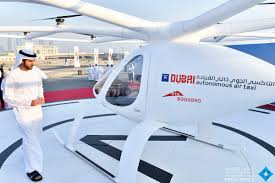Now Reading: “How UAE Is Redefining the Skies with Air Mobility Innovation 2025”
-
01
“How UAE Is Redefining the Skies with Air Mobility Innovation 2025”
“How UAE Is Redefining the Skies with Air Mobility Innovation 2025”

The United Arab Emirates (UAE) is once again turning heads worldwide, but this time it is not about skyscrapers or luxury shopping. Instead, the UAE is set to revolutionize the way people move—through the skies.
With advanced air mobility (AAM) projects under development, the country is fast becoming a leader in the futuristic world of flying cars, air taxis, and drone-based transportation. This ambitious vision reflects the UAE’s long-term plan to transform urban travel and reduce traffic congestion, pollution, and travel time—all while embracing cutting-edge technology.
What is Advanced Air Mobility (AAM)?

Advanced Air Mobility (AAM) refers to the use of new aircraft technologies, such as electric vertical take-off and landing vehicles (eVTOLs), to carry passengers or cargo at low altitudes over urban areas. These air vehicles are designed to be eco-friendly, efficient, and fast, offering an alternative to traditional ground transportation.
In simple words, AAM could mean flying taxis taking passengers directly from downtown Dubai to the airport in just a few minutes—or drones delivering packages to your doorstep without touching the roads.
Why UAE Is Investing Big in Air Mobility

The UAE has always embraced technology and innovation at an impressive pace. From the world’s tallest building—the Burj Khalifa—to space exploration, the country continues to dream big. Now, the sky is literally the limit.
Here are key reasons why the UAE is pushing for AAM:
- Reduce Road Traffic:
Dubai and Abu Dhabi face increasing traffic congestion. Air taxis can cut travel time between key locations by up to 70%. - Eco-Friendly Transport:
eVTOL aircraft produce zero emissions and reduce reliance on fossil fuels, helping the country achieve its sustainability goals. - Tourism Boost:
Air taxis and aerial sightseeing tours can offer tourists unique, unforgettable experiences—further boosting the UAE’s tourism industry. - Global Leadership:
Becoming the first country to launch widespread AAM services would put the UAE ahead of global competitors like the US, Germany, and China.
Major Players and Projects in UAE’s AAM Scene
Several big names are partnering with the UAE government and private firms to bring air mobility to life:
- Joby Aviation and Dubai RTA Collaboration:
California-based Joby Aviation has signed a deal with Dubai’s Roads and Transport Authority (RTA) to launch air taxi services by 2026. The plan includes four initial “vertiports” in locations like Dubai International Airport and Downtown Dubai. - EHang and Abu Dhabi Partnerships:
Chinese drone giant EHang is working with Abu Dhabi’s Department of Municipalities to introduce passenger drones and logistics services. These drones may soon ferry tourists around Yas Island or deliver parcels across the city. - Volocopter Testing:
German company Volocopter successfully tested its air taxi prototype in Dubai as early as 2017. More advanced trials and certification efforts are ongoing. - Skyports Infrastructure Development:
Skyports is developing “vertiports” across the UAE—special landing pads and terminals for eVTOL aircraft, similar to today’s helipads but far more sophisticated.
What Will Air Mobility in the UAE Look Like?
Imagine booking an air taxi on an app—just like Uber. Instead of waiting in traffic for an hour, you hop into a small electric aircraft, and in 10 minutes you arrive at your destination. No noise, no emissions, no hassle.
These aircraft can carry 2–4 passengers and are designed to take off and land vertically, needing no runway. Once vertiports are built across cities, trips between airports, tourist attractions, and business hubs will become fast and easy.
Additionally, cargo drones will help move goods between warehouses, ports, and retail centers—making supply chains faster and more efficient.
Challenges Ahead
While the vision is exciting, several hurdles remain:
- Regulation:
Flying cars need strict airspace management and safety approvals. The UAE is working with global aviation bodies to create the right laws. - Infrastructure:
Vertiports, charging stations, and maintenance hubs must be built across cities—an expensive and time-consuming task. - Public Trust:
Will people feel safe flying in small, pilotless aircraft? Convincing the public will be key. - Cost:
Initial rides may be expensive. Mass adoption will depend on lowering prices over time.
Despite these challenges, the UAE is confident. The government’s pro-technology attitude, partnerships with global tech leaders, and solid financial resources put the country in a strong position to solve these problems quickly.
The Future: When Will We See Flying Cars in the UAE?
If all goes as planned, the first air taxi services could start as early as 2026. Dubai is expected to be the launch city, with Abu Dhabi close behind.
By 2030, experts believe air mobility could become a normal part of life in the UAE—especially for airport transfers, business trips, and tourism.
Long term, flying cars may even become affordable for the average commuter, replacing traditional cars for short urban trips.
Conclusion
Advanced Air Mobility is no longer science fiction in the UAE—it is becoming real. With the country’s strong commitment to technology and innovation, the dream of flying cars, sky taxis, and drone deliveries is taking shape fast.
The next time you visit Dubai or Abu Dhabi, don’t be surprised if you find yourself flying over the city instead of driving through it.
The skies are opening up—and the UAE is leading the way.
Read More:- Deyaar’s Latest Announcement Shakes Up the UAE Property Market


















